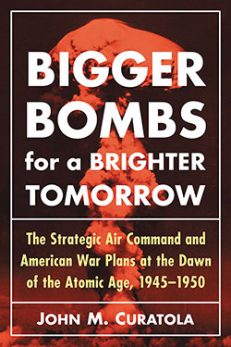Bigger Bombs for a Brighter Tomorrow
The Strategic Air Command and American War Plans at the Dawn of the Atomic Age, 1945–1950
$29.95
In stock
About the Book
Right after World War II, the United States felt secure in its atomic monopoly. With the American “Pax Atomica” in place, the free world held an apparent strategic advantage over the Soviet bloc and saw itself as a bulwark against communist expansion. But America’s atomic superiority in the early postwar years was more fiction than fact. From 1945 until 1950, the U.S. atomic arsenal was poorly coordinated, equipped and funded. The newly formed Atomic Energy Commission inherited from the Manhattan Engineer District a program suffering from poor organization, failing infrastructure and internal conflict. The military establishment and the Air Force’s Strategic Air Command little knew what to do with this new weapon. The Air Force and the AEC failed to coordinate their efforts for a possible atomic air offensive and war plans were ill-conceived, reflecting unrealistic expectations of Air Force capabilities and possible political outcomes. This lack of preparedness serves as a case study in the tenuous nature of American civilian-military relationships. Instructors considering this book for use in a course may request an examination copy here.
About the Author(s)
Bibliographic Details
John M. Curatola
Format: softcover (6 x 9)
Pages: 236
Bibliographic Info: 18 photos, notes, bibliography, index
Copyright Date: 2016
pISBN: 978-0-7864-9419-4
eISBN: 978-1-4766-2137-1
Imprint: McFarland
Table of Contents
Preface 1
Introduction 7
Part I. The Bomb
1. Mr. X and the Fiscal Year (FY) 50 Debate 23
2. The Atomic Energy Commission and the Fight Over Custody 37
3. Inter-Service Squabbles 65
Part II. American War Planning
4. The Postwar World and the USSBS 77
5. National Security Objectives? 88
6. War Plans 96
7. Assessments 124
Part III. Strategic Air Command
8. Men 135
9. Machines 154
Conclusion: Turning the Corner 175
Chapter Notes 195
Bibliography 215
Index 223
Book Reviews & Awards
“rich details…a crisp book that reads smoothly, presenting a wealth of solid information in a cogent way”—H-Net Reviews.





